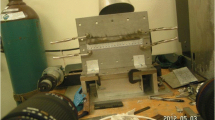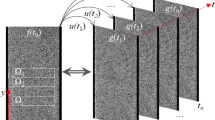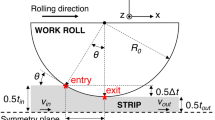Abstract
Currently, the primary method used to investigate weld bead distortions is based on finite element prediction. However, in this paper, we proposed a three-dimensional optical method based on weak digital image correlation technology to track the dynamic distortion of the weld bead throughout the welding and cooling process. An experimental investigation demonstrated that the weld bead zone was distorted into a dish shape during the welding process and changed into a saddle shape after cooling down. In the weld bead, the out-of-plate distortion was significantly larger than the in-plate distortion, and the longitudinal plastic strain distribution was small and uniform, whereas the transverse strain was larger. This optical experimental method could be useful in the validation of numerical models in the welding process and important to research on welding distortions.






Similar content being viewed by others
References
H. Murakawa, D. Deng, and N. Ma, Applications of inherent strain and interface element to simulation of welding deformation in thin-plate structures, Comput. Mater. Sci., 2011, 51, p 43–52
B. Pan, D.F. Wu, and Z.T. Gao, Study of non-contact optical metrology for full-field distortion measurement at 1200 °C, Struct. Environ. Eng., 2011, 38, p 52–59
J.C. Wang, N. Ma, and H. Murakawa, An efficient FE computation for predicting welding induced buckling in production of ship panel structure, Mar. Struct., 2015, 41, p 20–52
Y. Li, K. Wang, and Y.J. Jin, Prediction of welding distorted in stiffened structure by introducing thermo-mechanical interface element, J. Mater. Process. Technol., 2015, 216, p 440–446
Z. Barsoum, M. Ghanadi, and S. Balawi, Managing welding induced distortion—comparison of different computational approaches, Proc. Eng., 2015, 114, p 70–77
J.C. Wang, S. Rashed, and H. Murakawa, Mechanism investigation of welding induced buckling using inherent distorted method, Thin Walled Struct., 2014, 80, p 103–119
P. Michaleris, Modelling welding residual stress and distortion: current and future research trends, Sci. Technol. Weld. Join., 2011, 16, p 363–368
J.M. Sun, X.Z. Liu, and Y.G. Tong, A comparative study on welding temperature fields, residual stress distributions and deformations induced by laser beam welding and CO2 gas arc welding, Mater. Des., 2014, 63, p 519–530
J.C. Wang, X.Q. Yin, and H. Murakawa, Experimental and computational analysis of residual buckling distortion of bead-on-plate welded joint, J. Mater. Process. Technol., 2013, 213, p 1447–1458
Y.Q. Guo, D.J. Wu, and G.Y. Ma, Numerical simulation and experimental investigation of residual stresses and distortions in pulsed laser welding of hastelloy C-276 thin sheets, Rare Metal Mater. Eng., 2014, 43, p 2663–2668
A. Gorkic, J. Mozina, and J. Diaci, Measurement of weld piece distortion during pulsed laser welding using rapid laser profilometry, Sci. Technol. Weld. Join., 2006, 11, p 48–56
H.K. Narang, M.M. Mahapatra, and P.K. Jha, Optimization and prediction of angular distortion and weldment characteristics of TIG square butt joints, J. Mater. Process. Technol., 2014, 23, p 1750–1758
Y. Javadi, M. Hasani, and S. Sadeghi, Investigation of clamping effect on the welding sub-surface residual stress and deformation by using the ultrasonic stress measurement and finite element method, J. Nondestruct. Eval., 2015, 34, p 3
R. Steindler, High-temperature strain-gage behavior on carbon materials, Exp. Mech., 1988, 9, p 244–246
Y.H. Huang, L. Liu, and F.C. Sham, Optical strain gauge vs. traditional strain gauges for concrete elasticity modulus determination original research, Optic, 2010, 121, p 1635–1641
R. Wang, J.X. Zhang, and C. Liu, Welding distortion investigation in fillet welded joint and structure based on iterative substructure method, Sci. Technol. Weld. Join., 2009, 14, p 396–403
D. Deng, Y.J. Zhou, and T. Bi, Experimental and numerical investigations of welding distortion induced by CO2 gas arc welding in thin-plate bead-on joints, Mater. Des., 2013, 52, p 720–729
V. Ocelik, J. Bosgra, and J. Hosson, In-situ strain observation in high power laser cladding, Surf. Coat. Technol., 2009, 203, p 3189–3196
M.D. Strycker, P. Lava, and W.V. Paepegem, Measuring welding distortions with the digital image correlation technique, Weld. J., 2011, 90, p 107–112
S.A.A.A. Mousavi and R. Miresmaeili, Experimental and numerical analyses of residual stress distributions in TIG welding process for 304 L stainless steel, J. Mater. Process. Technol., 2008, 208, p 383–394
M. Peric, Z. Tonkovic, and A. Rodic, Numerical analysis and experimental investigation of welding residual stresses and distortions in a T-joint fillet weld, Mater. Des., 2014, 53, p 1052–1063
Acknowledgments
The authors acknowledge the support of the National Natural Science Foundation of China (Grant No. 51421004, 51275378, 51275389) and the Fundamental Research Funds for the Central Universities. Comments from the anonymous reviewers are also greatly appreciated.
Author information
Authors and Affiliations
Corresponding author
Rights and permissions
About this article
Cite this article
Guo, N., Yin, X., Liang, J. et al. Weld Bead Distortion of Thin-Plate Using Weak Digital Image Correlation Method. J. of Materi Eng and Perform 25, 4952–4958 (2016). https://doi.org/10.1007/s11665-016-2286-y
Received:
Revised:
Published:
Issue Date:
DOI: https://doi.org/10.1007/s11665-016-2286-y




